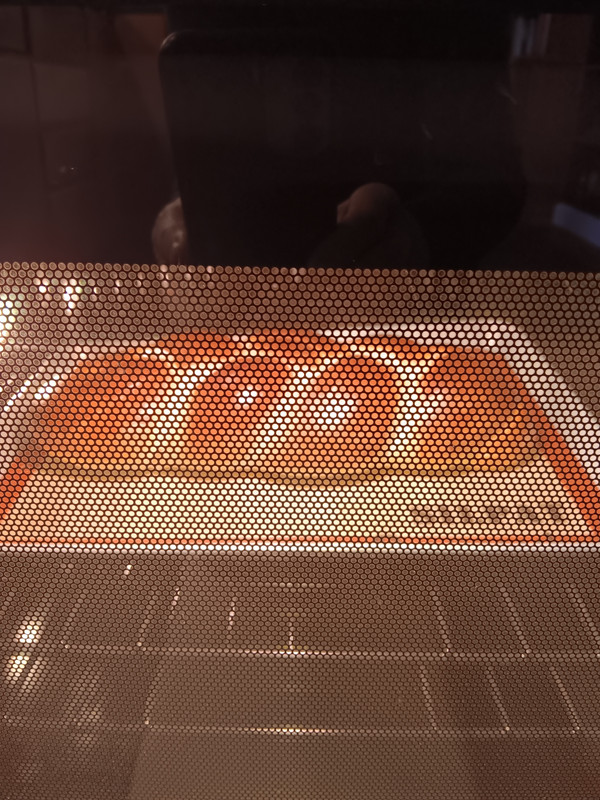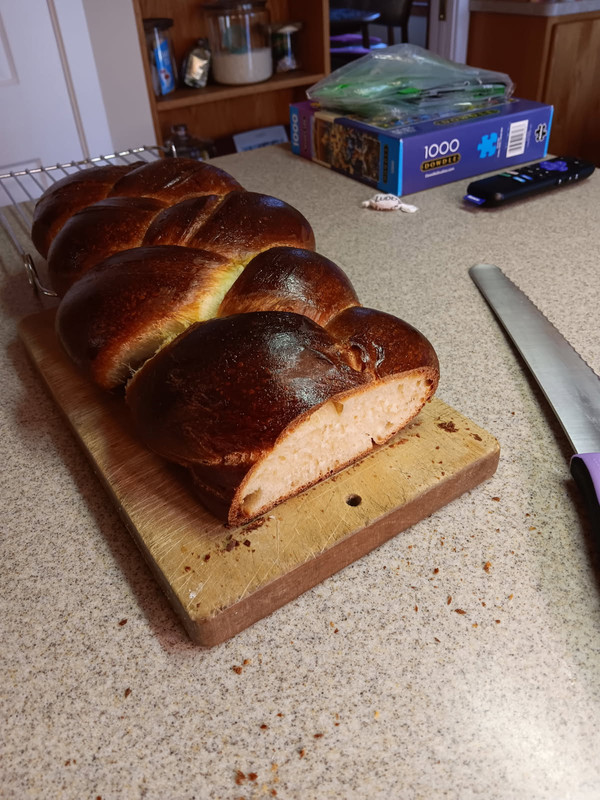Greetings from SFO!
-
Like @Jodi I don't put the salt directly on the starter when I'm putting together the ingredients to make a loaf of bread. I start with the starter (!), then put water on that, dump in the flour and sprinkle the salt on top of the flour. Stir everything together.
I do remember making a loaf of bread when I was a kid. The bread came out looking very nice, but much puffier and larger than usual. I cut a slice and buttered it and it became obvious why the loaf looked so different than usual. I forgot to put in the salt.
-
The theory is that if your starter is raised with salt in it then being combined with the salt in the dough won’t slow it down.
It’s one of many questionable assertions I’ve found bouncing around YouTube and Reddit.
@Steve-Miller said in Greetings from SFO!:
The theory is that if your starter is raised with salt in it then being combined with the salt in the dough won’t slow it down.
It’s one of many questionable assertions I’ve found bouncing around YouTube and Reddit.
Lots of things people do that make this more way more complicated than it needs to be! Temperature is one of the biggest factors in how fast it rises. I let the bread I made yesterday rise on the counter, it took a couple hours longer than it does in the oven with the light on. But since it didn’t matter when I baked it, it didn’t matter how long it took. And I could have just stuck it in the fridge and let it proof overnight and baked it this morning. Sourdough is something you just have to be willing to be flexible with, depending on your conditions/environment at the time.
-
She’s dead, Captain. The starter sleeps with the fishes.

It never really did much, got a bit lighter but never changed size. One or two bubbles. Today was the end of it - crusted over and smelled bad.
I may have done too many things. Different flours, sometimes discard, sometimes not. This time I’ll pick one method and stick with it.
Onward - In to the fog!
-
Use 100% rye flour, bobs red mill. Don’t add any other kind of flour until it’s going. It took mine a couple of weeks at least. Water needs to have no chlorine. Make sure your spoons are clean.
https://www.weekendbakery.com/posts/rye-sourdough-starter-in-easy-steps/
-
I’ve now made 2. One traditional with Rye flour, one using dehydrated starter from England that Sharon got me for Christmas. That one used unbleached bread flour.
Kitchen temp 69 degrees - I think putting in the oven even with just the light on may have baked it. Water temp used was 90F. Flour temp 69F. Distilled water.
Early results are encouraging - I’m getting bubbles!
-
Maybe bottled drinking water?
Maybe I’ll take some of the discard and feed it with tap water and see what happens. I have lots of jars and the tap water doesn’t smell like chlorine so…
-
You can just boil your tap water and cool it and then use it. Keep container in the fridge. Most tap water has chlorine added. Even if you can’t smell it. And wtg said her tap water works, so maybe yours won’t have enough to matter and will too. I’ve just always let it dissipate out of mine because that’s what was suggested.
-
I've never tried drying starter. If you get desperate, I can dry some of mine and send it to you. King Arthur has instructions for the whole process, from drying it, storing it, and reviving it:
https://www.kingarthurbaking.com/blog/2015/05/01/putting-sourdough-starter-hold
-
First attempt at sourdough challah in the oven. Meant to take a pic before it went in, and when I remembered, didn't want to open the oven and drop the temp.

Recipe was not good. The dough was more of a batter after I got to the end of the mixing stage. Had to add a ton more flour to get anything resembling the proper consistency. Rose modestly overnight and after I cut it into pieces and braided it into a loaf.
We'll see how it turns out, but I think I'll go with the King Arthur recipe for my next loaf.
I didn't need another baking utensil, but I bought a pullman loaf pan. That's the next bread experiment, probably next week.
-
Looks great!

-
Now to the point where the rye one doubles in size in 24 hours The wheat one gets fluffy but doesn’t change size much.
The rye one is much easier to work with than the wheat one. The wheat version sets up like concrete on whatever it touches while the rye one stays softer even if it sits on a counter or something.
Both seem to require more water than the 1:1 ratio everyone recommends. 1:1 gives a consistency something like peanut butter so I’ve been adding water until the surface of the starter will level out in the jar. The only reason I do this is to make it look like the pictures on line. Your thoughts?
I see people slowly switching their rye starter over to wheat before baking with it. Is this necessary?
-
I think my starter is more like peanut butter; I follow the 1:1 ratio.
Not sure what to say about the rye starter conversion. From what @Jodi said, seems like the rye may be better for getting the starter rolling. Your observations of your two starters seem to bear that out. I only recently started experimenting with rye, but I fed a wheat starter some rye, so I'm doing kind of the reverse conversion. The bread I made with the rye-fed starter was good but I'm not sure it's worth the effort to keep multiple starters going. I think if I want to do a rye bread, I'll just use some rye in the loaf I'm making. I find the rye flour makes the bread much sticker and harder to work with, so I only do it occasionally. Lazy bum!
This first week of getting the starter going is kind of like having a newborn or a puppy in the house, isn't it? They all need constant attention! I promise it'll get easier....
-
A pumpkin-shaped sourdough loaf. How cool!

https://www.mydailysourdoughbread.com/pumpkin-shaped-sourdough/



